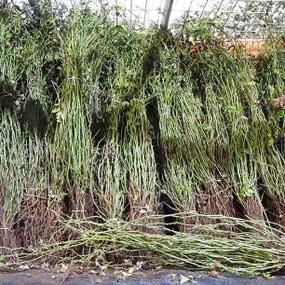Dog Rose Hedge Plants
Honest Delivery PricesRosa canina
Hedge Plants- Thorny, native wild rose.
- Grows almost anywhere.
- Good component for mixed country hedging.
- Max. Height: 3m
- Bareroot Delivery Only: Nov-Mar.
Description
Rosa canina: Bareroot Hedging
Delivered by Mail Order Direct from our Nursery with a Year Guarantee
Dog Rose is the cheapest and most commonly used native wild rose for use in prickly, secure country hedging. It is an incredibly hardy, fast-growing and versatile plant that will grow pretty much anywhere except on the very wettest sites. It carries clusters of single, scented pale pink flowers in early summer that bees love, and small red hips in autumn that attract birds.
Standing alone, they will grow to 1.5 metres, but when they are pushed up against other plants in a mixed hedge, they can reach over 3 metres.
View our selection of roses for hedging or see our range of thorny hedging plants.
Rosa canina hedge plants are only delivered bareroot, during winter (Nov-March).
All our hedge plants are measured by their height in centimetres above the ground (the roots aren't measured).
Features
- Native. Very prickly.
- Any soil except waterlogged.
- Tolerates shade well.
- Height: To 1.5m by itself, or over 3m in a mixed hedge.
- Pale pink, scented flowers.
- Red rose hips in autumn.
- Great for bees & other insects.
- Bareroot Delivery Only Nov-March
Growing Dog Rose
As a hedge plant, it will grow anywhere with a bit of sun and soil that is not waterlogged. If you are growing it as a shrub, it likes full sun to flower and fruit really well.
Spacing a Dog Rose hedge:
Standard country hedging: plant at 3 per metre, 33cm apart in a single row, or 6 per metre in a staggered double row, which has a W shape viewed top-down.
You can grow it as a climber/rambler over a fence, wall, or up a tree.
Dog Rose in your Garden
It is a very common component of mixed country hedging. It will make a decent enough, shaggy country hedge by itself, but it needs something like Hawthorn or Blackthorn to give it more structure.
Wild roses aren't often used as specimen shrubs, probably because there are so many amazing ornamental roses to choose from, but if your priority is helping wildlife, then they are the best choice by far.
Did You Know?
Other common names include dog, hep or bird briar, cankerberry, and cat whin.
When you see roses in medieval era heraldry, they are usually based on this one.
The oldest known specimen is the Tausendjähriger Rosenstock, the Thousand-years rosebush, growing up the side of Hildesheim Cathedral in Germany. It is about 9 metres tall and survived the carpet bombing by Allied forces that destroyed the cathedral itself in 1945, regrowing from the roots well before the cathedral was rebuilt.
It is on the RHS list of plants for pollinators.
Planting Instructions
Growing Rosa canina plants:
These wild roses are hard as nails and will grow pretty much anywhere, even on ground that is prone to waterlogging. It is fine in very exposed locations near the coast and on chalky soil. It is pretty shade tolerant, but it won't flower much if it doesn't get enough sun.
Prepare your site before planting:
Native hedge plants like Rosa canina are very tough. The only essential preparation is to kill the weeds in a strip a metre wide along the planting site: improving the soil should not be necessary. If your soil is exceptionally poor and dry, then digging in some well rotted manure and/or compost is worthwhile.
Watch our video on how to plant a country hedge for full details.
Remember to water establishing plants during dry weather for at least a year after planting.
Hedge Planting Accessories:
Prepare your site for planting by killing the weeds and grass.
You can buy a hedge planting pack with sheets of mulch fabric and pegs to hold it down.
If your soil quality is poor, we recommend using mycorrhizal "friendly fungi" on the roots of new trees and shrubs.
You can also improve your soil with bonemeal organic fertiliser.

 1.webp)
 1.webp)
 2.webp)
 3.webp)
